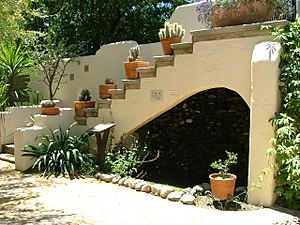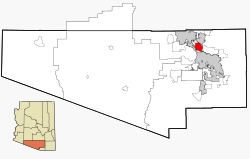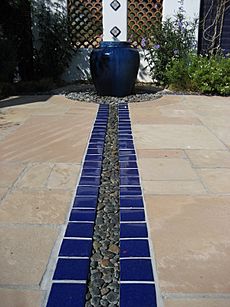Casas Adobes, Arizona facts for kids
Quick facts for kids
Casas Adobes, Arizona
|
|
|---|---|

Garden in Tohono Chul Park
|
|

Location in Pima County and Arizona
|
|
| Country | United States |
| State | Arizona |
| County | Pima |
| Area | |
| • Total | 26.75 sq mi (69.29 km2) |
| • Land | 26.64 sq mi (69.01 km2) |
| • Water | 0.11 sq mi (0.28 km2) |
| Elevation | 2,411 ft (735 m) |
| Population
(2020)
|
|
| • Total | 70,973 |
| • Density | 2,663.65/sq mi (1,028.43/km2) |
| Time zone | UTC-7 (MST (no DST)) |
| FIPS code | 04-10670 |
| GNIS ID | 37210 |

Casas Adobes means "Adobe Houses" in Spanish. It is a community in northern Tucson, Arizona, located in Pima County. It is called a census-designated place (CDP) because it's a special area defined for gathering population data. In 2020, about 70,973 people lived here. Casas Adobes is found south of Oro Valley and west of Catalina Foothills.
Contents
What is the history of Casas Adobes?
Casas Adobes is an older community, even older than the nearby towns of Oro Valley and Marana. For a long time, the land was mostly used by cattle ranchers. This was especially true in the areas near the Cañada del Oro to the north and the Rillito River to the south.
How did early settlers shape Casas Adobes?
Cattle ranches were common in Casas Adobes until the 1920s. At that time, Tucson began to grow north, and cars made it easier to reach the area. This led to new people settling and building homes.
Maurice Reid's citrus groves
One of the first people to build a home here was Maurice L. Reid. He moved to Tucson in 1923 for his health. In the late 1920s, Reid bought a large ranch of about 1,500 acres (6.1 km²). He planted over 200 acres (0.81 km²) of citrus trees and date palms. This became a major part of Tucson's citrus industry. Over the years, Reid sold parts of his land for homes. Some large homes still have citrus groves today.
Rancho Nezhone: A famous guest ranch
Leonie Boutall moved to Arizona from Tennessee in the early 1930s. Her doctor suggested the dry climate for her health. She bought 100 acres (0.40 km²) of land and built Rancho Nezhone. This was a fancy guest ranch that attracted many rich and famous people. Guests included Kate Smith, Liberace, and William "Hopalong Cassidy" Boyd. The ranch had beautiful plants, monkeys, and parrots. Boutall sold the property in 1948. Today, it is the Mission Palms Apartments, but some original features, like a stone wall, are still there.
Sam Nanini's housing developments
Sam and Giaconda Nanini moved to Tucson in 1948 for Giaconda's health. In the mid-1950s, Sam Nanini developed three neighborhoods on about 300 acres (1.2 km²). These areas became the center of the Casas Adobes community and gave it its name. These neighborhoods, along with the Casas Adobes Plaza, were seen as Tucson's first suburb. Many homes in these areas are large ranch-style houses made with adobe bricks. Sam Nanini and his son William also built the Tucson National Resort and the Tucson National Estates homes.
Why did Casas Adobes not become a city?
In 1997, a new law allowed Casas Adobes residents to vote to become their own city. However, this law was later found to be against the state's constitution. So, the plan to become a city was canceled. Another vote to become a city in 2001 also failed.
Casas Adobes has grown to cover about 23 square miles (60 km²). It has nearly 60,000 residents. Unlike its neighbors, Oro Valley, Marana, and Tucson, Casas Adobes is mostly developed. Because it didn't become a city, it's possible that parts of Casas Adobes might be added to these nearby towns in the future.
Where is Casas Adobes located?
Casas Adobes is located at 32°20′47″N 111°0′35″W.
The United States Census Bureau says that the community covers a total area of 22.6 square miles (58.6 km²). Almost all of this area is land, with only a very small part being water.
What is the population of Casas Adobes?
| Historical population | |||
|---|---|---|---|
| Census | Pop. | %± | |
| 2000 | 54,011 | — | |
| 2010 | 66,795 | 23.7% | |
| 2020 | 70,973 | 6.3% | |
| U.S. Decennial Census | |||
In 2000, there were 54,011 people living in Casas Adobes. There were 22,066 households and 14,718 families. The population density was about 2,387 people per square mile (922/km²).
About 29.8% of households had children under 18. The average household had 2.40 people. The average family had 2.93 people.
The median age in Casas Adobes was 39 years old. About 23.0% of the population was under 18. About 16.1% were 65 years or older.
What schools are in Casas Adobes?
Casas Adobes is served by three different public school districts:
- Amphitheater Public Schools: This is the main school district for Casas Adobes. Some of its schools, like Canyon del Oro High School, are known for being top-performing. Newsweek Magazine recognized Canyon del Oro as one of the best public schools in the U.S. in 2007 and 2010. Amphitheater High School serves the southern parts of Casas Adobes.
- Elementary schools in Casas Adobes include Marion Donaldson, Winifred Harelson, Mesa Verde, and Lulu Walker.
- La Cima Middle School is also located in Casas Adobes.
- Marana Unified School District: This district serves the far northwestern areas of Casas Adobes. Mountain View High School is the high school for this area.
- Elementary schools in Casas Adobes include Butterfield, Ironwood, and Thornydale.
- Flowing Wells Unified School District: This district serves the far western parts of Casas Adobes. Flowing Wells High School serves students in this area.
Are there public libraries in Casas Adobes?
Yes, the Pima County Public Library operates the Nanini Branch Library in Casas Adobes.
What are some interesting places in Casas Adobes?
Casas Adobes has some unique and interesting places to visit:
Tohono Chul Park
Tohono Chul Park is one of southern Arizona's largest nature preserves. It is a private park dedicated to protecting the desert and teaching visitors about its plants and wildlife. "Tohono Chul" means "desert corner" in the Tohono O'odham language. It was created in 1985 by Richard and Jane Wilson, who donated their home and land.
Mid-century modern architecture
Casas Adobes has many examples of Mid-century modern architecture. This style was popular in the middle of the 20th century. Famous architects like Friedman and Jobusch, Nicholas Sakellar, and Edward Nelson designed buildings here. Examples include Saint Odilia Catholic Church, St Andrew's Presbyterian Church, and Dove of Peace Lutheran Church. Many homes in neighborhoods like Catalina Village and Westward Look Estates also show this style.
Casas Adobes Plaza
The Casas Adobes Plaza is a shopping area that opened in 1948. It is known for its beautiful Mediterranean architecture. You can see original Italian designs, statues, and fountains. The plaza also has a historic Mediterranean observation tower.
Westward Look Resort
The Westward Look Resort started as a dude ranch in the early 1900s. It is located in the foothills of the Santa Catalina Mountains. In the 1960s, architect Edward Nelson expanded it, and it became Tucson's first resort. The original adobe home from the 1910s is still part of the resort.
Omni Tucson National Resort
The Omni Tucson National Resort is a famous golf resort built by Sam Nanini in the 1960s. It has hosted the PGA Tour Tucson Open for over forty years. Famous golfers like Jack Nicklaus, Arnold Palmer, and Lee Trevino have played here.
Casas Adobes is known as the oldest community among the suburbs north and northwest of Tucson.
See also
 In Spanish: Casas Adobes para niños
In Spanish: Casas Adobes para niños



